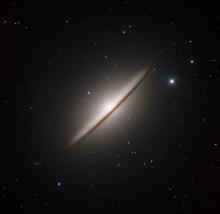Listen to today's episode of StarDate on the web the same day it airs in high-quality streaming audio without any extra ads or announcements. Choose a $8 one-month pass, or listen every day for a year for just $30.
You are here
More Transients
Hercules climbs into good view in the east and northeast a couple of hours after sunset. His torso is outlined by a lopsided square of stars known as the Keystone.
The constellation produced a big bang that was seen last June. It was cataloged as AT2018cow, and nicknamed “the Cow.”
The Cow was a fast-evolving luminous transient — a class of objects first seen only in the last few years. They flare up in a few days — far quicker than a typical supernova, which is a huge stellar explosion. And astronomers are having a tough time deciding what powers them.
A transient discovered in 2015, by the Kepler space telescope, flared up in just two days. Some astronomers suggested it was a supernova, but an odd one: The blast ran into gas around the star, producing a brilliant shock wave.
A couple of years later, another team produced another explanation for these transients: the merger of two stellar corpses known as white dwarfs.
The Cow produced even more possible explanations. One says that a massive star collapsed to form a black hole. “Jets” of material from the star rammed into the gas around it, creating the fireworks. Another explanation is that a black hole was eating a “normal” star. And yet another says the outburst was produced by a supernova with little gas around it. That allowed space telescopes to see gas falling onto a newborn neutron star or black hole — a possible explanation for some “flashy” stars.
Script by Damond Benningfield





